
Malagasy Ingredients: Unique Flavors, Culinary Uses and Health Benefits
Malagasy ingredients are unique native plants and spices that enrich the cuisine of Madagascar with…
Madagascar is a captivating destination known for its extraordinary biodiversity and vibrant culture, offering travelers a myriad of stunning locations from national parks to picturesque islands. To make the most of your visit, it's essential to plan your trip during the dry season from May to October, ensuring ideal weather for outdoor adventures and wildlife observation. Understanding the island's geography and travel logistics will help you create a memorable itinerary that showcases the best of what Madagascar has to offer.

Malagasy ingredients are unique native plants and spices that enrich the cuisine of Madagascar with distinctive flavors and numerous health benefits. Integral to local dishes, these ingredients not only enhance taste but also contribute to nutritional wellness through their rich phytochemical properties. From traditional recipes to modern culinary applications, they reflect the island’s vibrant cultural…
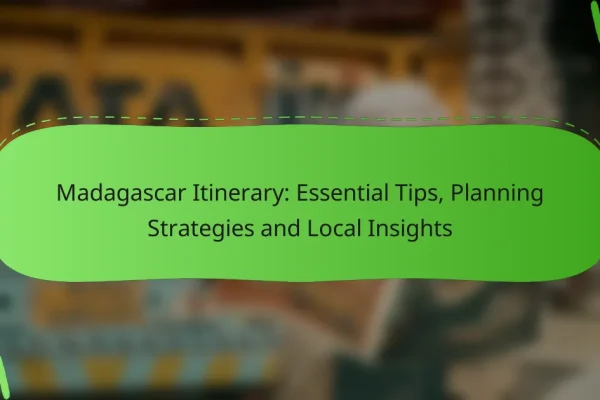
Madagascar offers a unique travel experience, with itineraries ranging from 7 to 14 days that showcase its stunning landscapes, rich cultures, and diverse wildlife. Effective planning is essential, as travelers should consider local conditions, weather variations, and cultural practices to enhance their journey. By researching travel logistics, budgeting appropriately, and understanding visa requirements, you can…
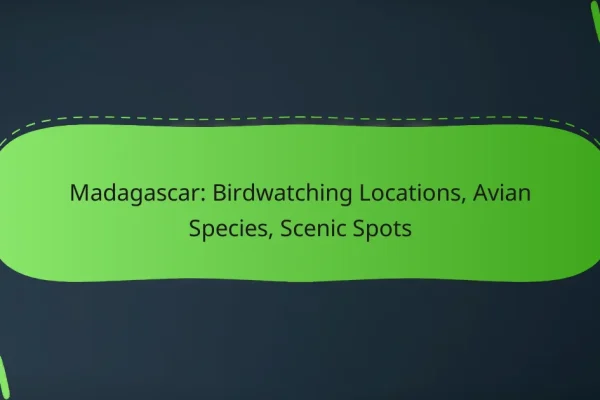
Madagascar is a premier destination for birdwatching, boasting unique locations that showcase its rich biodiversity and numerous endemic species. With its diverse habitats ranging from lush forests to coastal areas, birdwatchers can enjoy unparalleled opportunities to observe a variety of avian life in stunning natural settings. Where are the best birdwatching locations in Madagascar? Madagascar…

Madagascar boasts a diverse array of restaurants that celebrate its rich culinary heritage, offering authentic local dishes in inviting settings. Guests can enjoy a blend of traditional charm and modern flair, with cozy atmospheres and stunning views that elevate their dining experience. Attentive service from well-trained local staff further enhances the enjoyment of the island’s…

Madagascar is home to an extraordinary array of wildlife, and responsible viewing is essential to protect its unique ecosystems. By following ethical practices and established guidelines, visitors can enjoy the island’s biodiversity while minimizing their impact on the environment and supporting local communities. Embracing these principles ensures a rewarding experience for both travelers and the…
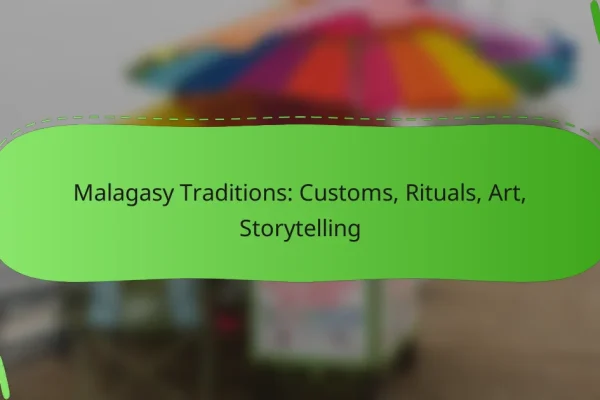
Malagasy traditions are a vibrant tapestry of customs, rituals, and artistic expressions that embody the island’s unique cultural heritage. These practices play a crucial role in community life, fostering connections and honoring ancestral legacies through ceremonies, taboos, and various art forms. From intricate wood carvings to captivating storytelling, each element reflects the deep-rooted values and…

Madagascar’s street food scene is a vibrant tapestry of flavors and dishes that reflect the island’s rich cultural heritage. From the savory Romazava to the sweet Mofo Gasy, each dish offers a unique taste of local ingredients and culinary traditions. Exploring bustling markets and food stalls in cities like Antananarivo and Nosy Be provides an…
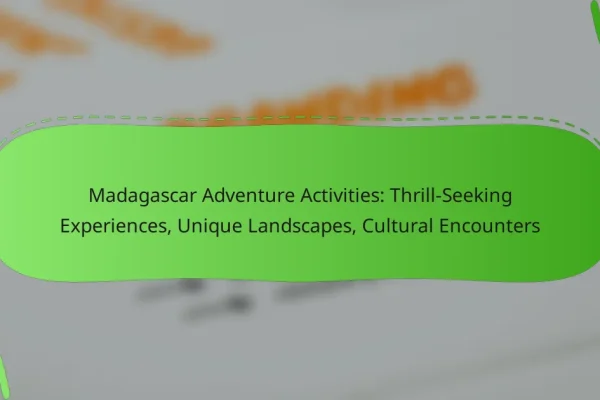
Madagascar is a paradise for adventure enthusiasts, offering a plethora of activities that range from exhilarating hikes in breathtaking national parks to snorkeling in its crystal-clear waters. The island’s unique landscapes and rich cultural heritage provide an unforgettable backdrop for thrilling experiences, allowing travelers to connect with local communities and traditions. Whether you’re seeking adrenaline…
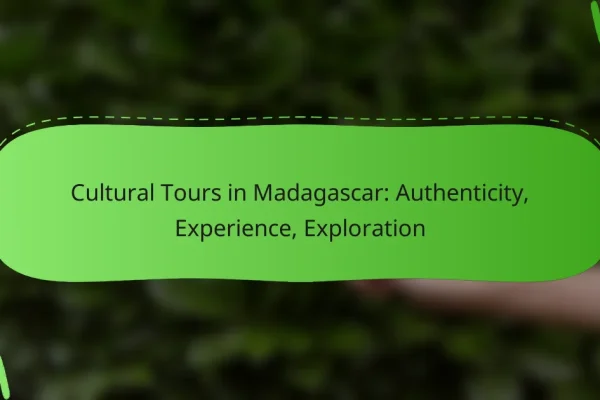
Embarking on a cultural tour in Madagascar promises an enriching journey through the island’s vibrant heritage and diverse traditions. These tours often include guided visits to national parks, city explorations, and immersive experiences that connect travelers with local customs and lifestyles. To ensure authenticity, it’s essential to choose local operators that emphasize community engagement and…
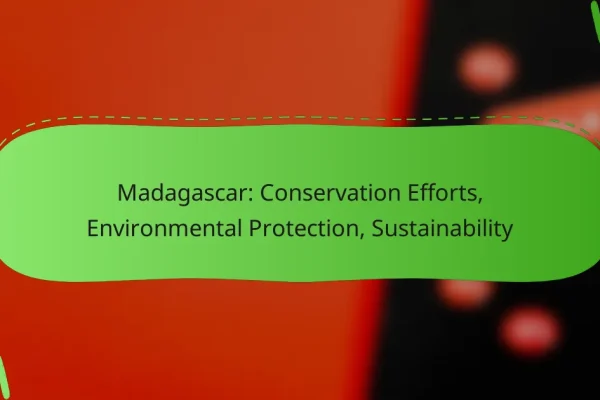
Madagascar is renowned for its unparalleled biodiversity, prompting significant conservation efforts aimed at protecting its unique ecosystems. These initiatives involve establishing protected areas, engaging local communities, and enforcing wildlife protection laws to combat environmental degradation. By promoting sustainable practices such as eco-tourism and renewable energy, Madagascar strives to balance economic development with ecological preservation. What…
Madagascar offers a variety of stunning travel destinations that showcase its unique biodiversity and rich culture. Key locations include national parks, beautiful islands, and vibrant cities, each providing distinct experiences for visitors.
Andasibe-Mantadia National Park is renowned for its lush rainforests and diverse wildlife, particularly the famous indri lemurs. Visitors can explore well-marked trails and enjoy guided night walks to spot nocturnal species.
When planning a visit, consider staying in nearby lodges that offer eco-friendly accommodations. The best time to visit is during the dry season from April to October, when wildlife sightings are more frequent.
Nosy Be is a tropical island known for its stunning beaches and vibrant marine life, making it a popular destination for relaxation and water sports. Activities such as snorkeling, diving, and boat tours to nearby islands are widely available.
To fully enjoy Nosy Be, plan your trip between May and October, when the weather is ideal. Be mindful of local customs and try the delicious seafood offered at beachside restaurants.
Isalo National Park features dramatic sandstone formations, canyons, and natural pools, providing a unique landscape for hiking and exploration. The park is home to various endemic species, including the ring-tailed lemur.
Hiking trails vary in difficulty, so choose routes that match your fitness level. The best time to visit is during the cooler months from May to September, when temperatures are more comfortable for outdoor activities.
Antananarivo, the capital city, offers a blend of history, culture, and modernity. Key attractions include the Rova of Antananarivo and local markets where visitors can experience the vibrant Malagasy culture.
While exploring the city, be cautious of your belongings and prefer guided tours for a safer experience. Local cuisine is a must-try, with dishes like romazava and ravitoto available in many eateries.
Ranomafana National Park is famous for its hot springs and rich biodiversity, including several species of lemurs. The park's dense rainforest provides excellent opportunities for wildlife observation and photography.
Visiting during the dry season from April to October is recommended for optimal wildlife viewing. Guided tours can enhance your experience, as local guides provide valuable insights into the park's ecology and conservation efforts.
The best time to visit Madagascar is during its dry season, which runs from May to October. This period offers pleasant weather, making it ideal for outdoor activities and wildlife viewing.
The dry season in Madagascar is characterized by lower humidity and minimal rainfall, making it a popular time for tourists. Average temperatures range from the low 20s to mid-30s Celsius, depending on the region.
This season is perfect for exploring national parks, such as Andasibe-Mantadia and Isalo, where wildlife is more active and visible. Travelers should book accommodations in advance, as this is peak tourist season.
The wet season brings higher humidity and frequent rain, particularly from December to March. While temperatures can still be warm, ranging from the mid-20s to low 30s Celsius, heavy downpours can disrupt travel plans.
Travelers during this time may find fewer crowds and lower prices, but should be prepared for muddy roads and potential flooding in some areas. It's advisable to check local weather forecasts and plan activities accordingly to avoid the worst of the rains.
Planning a trip to Madagascar involves understanding its unique geography, culture, and travel logistics. Key steps include selecting an itinerary, arranging accommodations, and considering transportation options to navigate this diverse island nation effectively.
Your itinerary should reflect Madagascar's rich biodiversity and cultural heritage. Popular destinations include the Avenue of the Baobabs, Andasibe-Mantadia National Park, and Nosy Be for beach relaxation. A typical trip might span 10 to 14 days to cover both wildlife experiences and cultural sites.
Consider focusing on specific regions to maximize your experience. For example, a week in the eastern rainforests can be complemented by a few days in the southern deserts, allowing you to witness the island's varied ecosystems.
Traveling within Madagascar can be challenging due to limited infrastructure. Domestic flights are available but can be expensive, while road travel often involves long journeys on unpaved roads. Renting a 4x4 vehicle is advisable for flexibility and access to remote areas.
Be prepared for varying weather conditions, especially during the rainy season from November to March. It's wise to check local advisories and plan your travel routes accordingly to avoid delays.
Madagascar offers a range of accommodations from budget hostels to luxury lodges. In urban areas like Antananarivo, you can find hotels that cater to all budgets, while rural areas often feature guesthouses or eco-lodges that provide a more immersive experience.
When booking, consider proximity to attractions and transportation options. It's advisable to reserve accommodations in advance, especially during peak tourist seasons from July to September, to ensure availability and better rates.
Madagascar offers various transportation options that cater to different travel needs and budgets. The most common methods include domestic flights, taxi-brousse, and car rentals, each with its own advantages and considerations.
Domestic flights in Madagascar are a quick way to cover long distances, especially between major cities like Antananarivo, Nosy Be, and Tulear. Airlines such as Air Madagascar and Tsaradia operate regular flights, which can save time compared to road travel.
When booking flights, consider purchasing tickets in advance to secure better prices, as last-minute fares can be significantly higher. It's advisable to check the flight schedules, as they can change frequently, and delays are not uncommon.
Taxi-brousse, or shared minivans, are a popular and budget-friendly way to travel between towns and cities in Madagascar. They operate on fixed routes and are often filled with locals, providing an authentic travel experience.
While taxi-brousse is economical, expect longer travel times due to frequent stops and varying road conditions. It's best to arrive early at the departure point, as these vehicles leave when full, and be prepared for a crowded ride.
Renting a car in Madagascar offers flexibility and the opportunity to explore at your own pace. Several local and international rental companies operate in major cities, providing options for both standard and 4x4 vehicles, which are recommended for rural areas.
Keep in mind that driving conditions can be challenging, with poorly maintained roads and limited signage. It's essential to have an international driving permit and to familiarize yourself with local traffic laws. Additionally, consider hiring a local driver for a smoother experience, especially if you're unfamiliar with the area.
Madagascar offers a rich tapestry of cultural experiences that reflect its diverse heritage. Visitors can immerse themselves in traditional music, savor local cuisine, and explore vibrant craft markets, each providing a unique glimpse into the island's cultural identity.
Traditional music and dance are integral to Madagascar's cultural fabric, often performed during festivals and ceremonies. The island's music features unique instruments like the valiha, a bamboo tube zither, and the marovany, a box zither, creating distinct sounds that resonate with local folklore.
Dance styles vary by region, with the most notable being the Tsapiky from the southwest and the Hira Gasy from the highlands. Engaging with local performances provides an authentic experience and a deeper understanding of Malagasy traditions.
Madagascar's local cuisine is a delightful blend of flavors influenced by African, Asian, and French culinary traditions. Rice is a staple, often served with a variety of side dishes, including zebu (beef), fish, and vegetables, seasoned with local spices.
Popular dishes include Romazava, a meat and vegetable stew, and Ravitoto, made with cassava leaves. Street food is also abundant, offering quick bites like mofo gasy (rice cakes) and koba (a sweet treat made from rice flour and peanuts).
Craft markets in Madagascar are vibrant hubs where artisans showcase their skills and sell handmade goods. Visitors can find a variety of products, including intricate wood carvings, colorful textiles, and unique jewelry, often made from local materials.
Popular markets, such as the Analakely Market in Antananarivo, offer a chance to purchase authentic souvenirs while supporting local artisans. Bargaining is common, so be prepared to negotiate for the best prices.
Madagascar offers unique wildlife experiences, showcasing species found nowhere else on Earth. Visitors can encounter diverse ecosystems, from rainforests to deserts, each teeming with endemic flora and fauna.
Lemurs are perhaps the most iconic wildlife in Madagascar, with over 100 species inhabiting the island. They thrive in various environments, including rainforests, dry forests, and spiny forests. Popular locations to see lemurs include Andasibe-Mantadia National Park and Ranomafana National Park.
When planning a visit, consider guided tours for the best chances to spot these fascinating creatures. Early morning or late afternoon are ideal times for lemur watching, as they are most active during these hours.
Madagascar is a birdwatcher's paradise, home to around 300 bird species, with nearly half being endemic. Notable birds include the Madagascar fish eagle and the blue vanga. Key birdwatching sites include Masoala National Park and the wetlands of Lake Alaotra.
To enhance your birdwatching experience, bring binoculars and a field guide. Joining a local birding tour can also provide insights into the best spots and times for sightings.
The waters surrounding Madagascar boast rich marine biodiversity, making snorkeling and diving popular activities. Coral reefs near Nosy Be and the Mitsio Archipelago are particularly vibrant, teeming with colorful fish and unique marine species.
For an optimal experience, consider visiting during the dry season, from May to October, when visibility is best. Local operators offer guided snorkeling tours, which can enhance safety and provide equipment.
Conservation is crucial in Madagascar due to threats like deforestation and habitat loss. Many national parks and reserves focus on protecting wildlife and their habitats. Organizations often run eco-tourism initiatives that support local communities while promoting wildlife conservation.
Travelers can contribute by choosing eco-friendly tours and respecting wildlife regulations. Supporting local guides and businesses helps ensure that conservation efforts remain sustainable and effective.